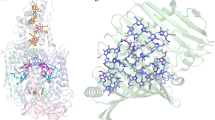Abstract
We have investigated the changes in the pigment composition and organisation of the light-harvesting apparatus of the green sulfur bacterium Chlorobium tepidum growing under different light intensities. Cells grown at lower light intensities had lower exponential growth rates and increased amounts of the main light-harvesting pigments, bacteriochlorophyll c and carotenoids, on a cell protein basis. Absorption spectra of chlorosomes isolated from cells grown at low light intensities revealed a red-shift of up to 8 nm in the Qy band of bacteriochlorophyll c compared to chlorosomes from high light grown cells. A similar red-shift of up to 4 nm was also observed in the corresponding fluorescence emission peaks. HPLC analysis of pigment extracts showed a correlation between the red-shift and the content of the more alkylated BChl c homologs, which increased as light intensity for growth was lower. Furthermore, analysis of the carotenoid composition in chlorosomes re vealed a conspicuous change in the ratio between chlorobactene and 1′, 2′-dihydrochlorobactene, which dramatically decreased from 5 to 0.7 in light-limited cultures.
Similar content being viewed by others
References
Blankenship RE, Wang J, Causgrove TP and Brune DC (1990) Efficiency and kinetics of energy transfer in chlorosome antennas from green photosynthetic bacteria. In: Baltscheffsky M (ed) Current Research in Photosynthesis, Vol II, pp 17–24. Kluwer Academic Publishers, Dordrecht
Blankenship RE, Olson JM and Miller M (1995) Antenna complexes from green bacteria. In: Blankenship RE, Madigan MT and Bauer CE (eds) Anoxygenic Photosynthetic Bacteria, pp 399–435. Kluwer Academic Publishers, Dordrecht
Bobe FW, Pfennig N, Swansson KL and Smith KM (1990) Red shift of the absorption maxima in Chlorobiineae through enzymic methylation of their antenna bacteriochlorophylls. Biochemistry 29: 4340–4348
Borrego CM and Garcia-Gil LJ (1994) Separation of bacteriochlorophyll homologues from green photosynthetic sulfur bacteria by reversed-phase HPLC. Photosynth Res 41: 157–163
Borrego CM and Garcia-Gil LJ (1995) Rearrangement of light harvesting bacteriochlorophyll homologues as a response of green sulfur bacteria to low light intensities. Photosynth Res 45: 21–30
Borrego CM, Garcia-Gil LJ, Vila X, Cristina XP, Figueras JB and Abella CA (1997) Distribution of bacteriochlorophyll homologs in natural populations of brown-coloured phototrophic sulfur bacteria. FEMS Microbiol Ecol 24: 301–309
Broch-Due M and Ormerod JG (1978) Isolation af a BChl c mutant from Chlorobium with BChl d by cultivation at low light intensities. FEMS Microbiol Lett 3: 305–308
Broch-Due M, Ormerod JG and Fjerdingen B (1978) Effect of light intensity on vesicle formation in Chlorobium. Arch Microbiol 116: 269–274
Frigaard NU, Larsen KL and Cox RP (1996) Spectrochromatography of photosynthetic pigments as a fingerprinting technique for microbial phototrophs. FEMS Microbiol Ecol 20: 69–77
Fuhrmann S, Overmann J, Pfennig N and Fischer U (1993) Influence of vitamin B12 and light on the formation of chlorosomes in green-and brown-colored Chlorobium species. Arch Microbiol 160: 193–198
Holo H, Broch-Due M and Ormerod JG (1985) Glycolipids and structure of chlorosomes in green bacteria. Arch Microbiol 143: 94–99
Huster MS and Smith KM (1990) Biosynthetic studies of substituent homologation in bacteriochlorophyll c and d. Biochemistry 29: 4348–4355
Larsen KL, Miller M and Cox RP (1994) Incorporation of exogenous long-chain alcohols into bacteriochlorophyll c homologs by Chloroflexus aurantiacus. Arch Microbiol 163: 119–123
Lowry OH, Rosebrough NH, Farr AL and Randall RJ (1951) Protein measurements with Folin phenol reagent. J Biol Chem 193: 265–275
Ma Y-Z, Cox RP, Gillbro T and M Miller (1996) Bacteriochlorophyll organization and energy transfer kinetics in chlorosomes from Chloroflexus aurantiacus depend on the light regime for growth. Photosynth Res 47: 157–165
Nozawa T, Ohtomo K, Suzuki M, Morishita Y and Madigan MT (1993) Structures of bacteriochlorophyll c's in chlorosomes from a new thermophilic bacterium Chlorobium tepidum. Chem Lett 1763–1766
Oelze J (1985) Analysis of bacteriochlorophylls. Meth Microbiol 18: 257–284
Ormerod JG, Aukrust TW and Johnsen IJ (1993) Frugal Chlorobium: The ultimate phototroph. In: Guerrero G and Pedrós-Alió C (eds) Trends in Microbial Ecology, pp 59–62. Spanish Society for Microbiology
Overmann J, Cypionka H and Pfennig N (1992) An extremely low-light adapted phototrophic sulfur bacterium from the Black Sea. Limnol Oceanogr 37: 150–155
Savitsky A and Golay MJE (1964) Smoothing and differentiation of data by simplified least-squares procedures. Anal Chem 36: 1627–1639
Schmidt K (1980) A comparative study on the composition of chlorosomes (Chlorobium vesicles) and cytoplasmic membranes from Chloroflexus aurantiacus strain Ok-70-fl and Chlorobium limicola f. thiosulfatophilum strain 6230. Arch Microbiol 124: 21–31
Smith KM and Bobe FW (1987) Light adaptation of bacteriochlorophyll-d producing bacteria by enzymic methylation of their antenna pigments. J Chem Soc Chem Comm, pp 276–277
Staehelin LA, Golecki JR and Drews G (1980) Supramolecular organization of chlorosomes (Chlorobium vesicles) and of their membrane attachment site in Chlorobium limicola. Biochim Biophys Acta 548: 427–432
Steensgaard DB, Cox RP and Miller M (1996) Manipulation of the bacteriochlorophyll c homolog distribution in the green sulfur bacterium Chlorobium tepidum. Photosynth Res 48: 385–393
Takaichi S, Wang ZY, Umetsu M, Nozawa T, Shimada K and Madigan MT (1997) New carotenoids from the thermophilic green sulfur bacterium Chlorobium tepidum: 1′,2′-dihydro-ε-carotene, 1′,2′-dihydrochlobactene and OH-chlorobactene glucoside ester, and the carotenoid composition of different strains. Arch Microbiol 168: 270–276
Wahlund TM, Woese CR, Castenholz RW and Madigan MT (1991) A thermophilic green sulphur bacterium from New Zealand hot springs, Chlorobium tepidum sp. nov. Arch Microbiol 146: 81–90
Author information
Authors and Affiliations
Rights and permissions
About this article
Cite this article
Borrego, C.M., Gerola, P.D., Miller, M. et al. Light intensity effects on pigment composition and organisation in the green sulfur bacterium Chlorobium tepidum. Photosynthesis Research 59, 159–166 (1999). https://doi.org/10.1023/A:1006161302838
Issue Date:
DOI: https://doi.org/10.1023/A:1006161302838




